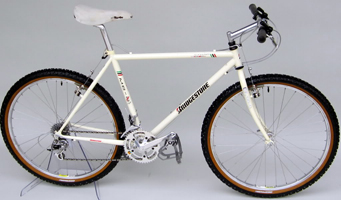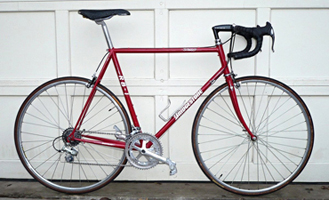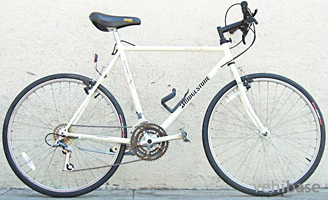


Bridgestone RB-0 Concept
Part Diary,
Part Technical Manual, Part Tips & Tricks



5/26/2017 - After updating this website for nearly ten years, I've always created a page after I acquired a bike. I get the bike or frameset, think about it for a while to develop a plan. However this is the first time I'm starting a new page in anticipation of my next project - an RB-0. This is a bike that does not exist and has never been made. I've been casually thinking about this project for years, just some quick thoughts, nothing specific. In the past few weeks, I've been thinking about the topic a lot more seriously. This is a play on some Grant Peterson concepts, a fictional hypothesis of how Grant would have built this bike if Bridgestone ever produced an RB-Zip. The initial inspiration is the MB-0 bikes that were made in 1990 and 1991. Traditionally, the top of the line Bridgestone was always the 1, whether it was a Road Bike (RB-1), Mountain Bike (MB-1), or City Bike (CB-1). But with this 0-series, it was better than their best, it was their hors catégorie edition.
Unlike their standard line of bikes, which emphasized a whole series of values (durability, safety, simplicity, servicable), the 0-series added one more value - lightness. Grant never seemed to emphasize lightness, it was always a by-product of using higher quality materials and components; but for the 0-series, it was an all out assault. He also didn't just accept the entire component gruppo concept, lazily trusting that the manufacturer would provide the perfect integrated system, instead he would hand pick every component based on its own merit. Grant also never blindly accepted new technology, it had to be better than the current technology while still upholding all of his values. Given that this project is happening over 25 years after these bikes were originally built, a lot of technological changes have developed over this period of time. I believe that if there is better newer technology that still upholds the original values, then it should be used. This is not a static period-correct build, but an evolving values-based build. Finally, the finished bike should have a factory look, original decals and colors, silver components, and shallow rim profiles. So in summary, the overarching goals of this project are:
* Traditional Bridgestone values + lightness
* Each component selected on its own merit
* Does not have to be period correct
* Factory look
6/22/2017 - After reviewing my thoughts below, it sure seems like modern components are better than old technology from every performance aspect. The only old technology that I plan on keeping is the downtube shifters, its only merit being weight and simplicity, but not as good or as safe as brifters. So now I'm starting to question to whole point of this project. If I stay restrained by being period correct, I'll have a very expensive and only marginally lighter bike. If I am not restrained by being period correct, then I'll basically end up with a frameset painted Tusk, a complete SRAM groupset, and a lightweight wheelset, that would simply be a restomod, which just doesn't seem that interesting.
Thinking back to the type of changes Grant was objecting to in the late 80s and early 90s:
* Oval chainrings - the fad that died and is now again. I still don't know or particularly care if there is a performance benefit or not. If the bike I'm riding has Biopace chainrings, I'll just ride them.
* Cheaply made parts that were not servicable - I think this may be a backlash from the 70s bicycle boom, the market was flooded with cheap bikes with crude components. It feels that cycling has been moving upscale, so the quality of components is quite high. Material science drives material choices, so steel, aluminum, and carbon fiber are all used to take advantage of their phyiscal properties. Because engineering is so sound and the manufacturing is so precise now, the whole concept of servicing/rebuilding components is kind of outdated. I imagine if you maintained a modern mid-level road bike properly, you can get at least 10,000 miles out of the components before they physically wear out, except for the chain, chainring, and tires. I think the durability of modern bikes has exceeded the physical abilities of 99% of bike riders, we replace bikes not because they are worn-out but because we want a new bike.
* Cassette gear escalation - from 1, 3, 5, 6, 7, 8, 9, 10, and now 11 gears in the back, the escaltion continues just like the number of blades on a razor. I totally agree that the number of speeds is the stupidest part of bicycle marketing. Anything between 6 to 9 gears feels like more than adequate. Actually only one thing matters, the number of teeth on your largest cog, the rest is just filler. I don't imagine there are too many riders pushing 53x12 wishing they had that 11t cog!
* The fussiness of index shifting adjustment - it is true that you really can't screw up friction shifting and a poorly adjusted index shifter will make a bike nearly unridable. However, index shifting is now about 30 years old now and the technology is pretty darn bullet proof now. The pride of being a really good friction shifter is dying, just like the art of driving a manual gearbox is becoming a less useful skill.
* Dying craftsmanship - craftsmanship is also becoming an outdated concept because people aren't really making anything mechanical anymore. People still work with wood, metal, and textiles, but no one is forging cranks, polishing metal, or assembling a derailleur by hand. It is true, craftmanship is dead, but it has been replaced with precise manufacturing. The resultant product may look different, but that doesn't make it bad, its probably better.
I think I may have started looking at this project way too ambitiously, nothing wrong with a high quality frameset with a shiny new coat of paint and some upgraded components. I'm thinking DA 7700 or Ultegra 6500 could work out well because it such a transitional group. It finally ended the square taper era with the introduction of Octalink and has all the underpinnings of a modern groupset, but still offered a downtube shifter, while retaining an overall traditional look. That would fundamentally achieve most of the goals I've outlined for this project.
2/4/2018 - I picked up the painted frameset on Friday, it looks really nice, but it reminded me that I still don't have a clear direction on the groupset. There has been so much technological improvements in the last 25 years, its really hard to decide on the right time (period correct: Mavic or DA 7400, transitional: DA 7700 or Ultegra 6500, or modern: SRAM Rival, Campagnolo Potenza or NOS: SRAM Apex in Alpine White or 2015 Campy Veloce. I never considered Campy, until I realized they still produce a groupset in silver, providinig that traditional look with modern features. Besides, when did they start making a groupset called Potenza? Seriously, as in Bridgestone Potenza, the tires I currently have on one of my cars? Maybe that is a sign. Another interesting route is to go Alpine White Apex, which goes with the Tusk frameset, but in a totally non-factory look.
10/2/2018 - many months later, still no decision on the project. Yesterday I actually starting thinking of putting on Shimano Santé, which was made from 1988-9. So it would preceed the frameset, but does not preceed the RB-1 series and it also shares 126mm rear spacing. The white on white would look good but with a traditional silhouette. The 7 speed cassette would be fine but the largest cog it can use is a 24T. Bridgestone did use Santé for one year on the 1988 Radac 3000.
The following are my component selection thoughts:
Frame: This is their top of the line frame to start with. According to Grant, 1991 was the finest year for the RB-1 frameset, with 90 and 92 also being very good. I will file off the pump peg, as this is an archaic feature. I'm also thinking about replacing the traditional brake cable guides with more modern cable stops. Strip the Rich Red paint and give it a coat of Tusk and new custom decals.
Fork: I plan on converting the steerer tube from threaded to threadless. Personally I feel the threadless headset is one of the top innovations in the past 25 years - it is lighter, simpler, more elegant, more convenient, and backwards compatible. I will also paint it Tusk to match the frame.
Crankset: Will look for a silver crankset for that traditional look, but with compact gearing. I have a couple bikes with the trendy 1X configuration, but I feel it is a limiting setup and with built-in bad chainline. This is a bad trend that will hopefully pass. A traditional double chainring with compact gearing is the way to go. Shimano Ultegra 6600/DA 7800/105 5750 or SRAM Rival/Force should fit the bill.
Bottom Bracket: The modern bottom bracket is simply a derivative of the threadless headset. Once again, stiffer, lighter, more elegant, more convenient, and backwards compatible. Once I select the crankset, the BB decision will simply follow.
Front Derailer: There will definitely be one, as I am not a fan of 1x drivetrains. I'm thinking a 28.6mm clamp-on as the most simple, strong, and direct type of derailleur.
Rear Derailer: If the cassette is no larger than a 28T, I can use pretty much anything, such as DA 7401. On second thought, it would be good to go with a MAVIC 840/841/845, which is compatible with 6-8 speeds.
Cassette: I will try to respect the original 7 speed, there are some options, 13-28 by Shimano. If I stay 28t or smaller, I can use any old school short cage derailleur. Or I can go with 130mm rear spacing and then that opens up a whole world of modern possibilities. In the past, it seemed that the more speeds, the more finicky the shifting adjustment must be, but having ridden 6sp through 10sp cassettes, I feel confident that the modern stuff shifts as reliably as anything else.
Chain: No real thoughts on chain technology progress, just something compatible with the selected drivetrain and lightweight.
Shifters: The shifters have to be on the downtube, nothing is simpler, lighter, and more expressive than those two little levers. If I go with MAVIC, then the 820 is the friction version and the 821 is the index version.
Brake Levers: The shape of original brake hoods were simply not very good, I think SRAM was the first company to really produce a very comfortable and ergonomic shape, causing the other major brands to catch up. SRAM makes a plain brake lever for each of its road groupsets to support their 1x option. Tektro also makes the RL340 lever with forged aluminum. The TRP RRL SR might be the right move here, drilled levers with gum hoods works with the colorway. The built-in quick-release button matches perfectly with the Mavic brakes which don't have a quick-release lever.
Brakes: Dual pivot brakes sure are nice - powerful, easy to adjust, holds its settings. Can keep it simple with DA 7700, but putting on some Mavic SSC seems like the right thing to do.
Rims: Planning on using vintage lightweight Mavic rims, lower spoke count helps with lightness, 32h or less.
Hubs: Any 7 speed era hub from Mavic or Dura-Ace. DA uses loose bearings which definitely wins the servicable criteria over Mavic's cartridge bearings.
Tires: Avocet no longer makes tires, so I'll probably go with a modern tire with a traditional look, such as the Vittoria Corsa with tan sidewalls. Instead of sticking with the original 28c, I think I'll go 25c, which is still larger than the 23c that I typically run.
Handlebar: Nitto Neat Model 104 or 185. The 104 is heat treated and lighter, but has a very shallow reach, the 185 looks loke a better bend.
Stem: If they make a silver Ritchey Force 1" threadless, that would be ideal, but I've only seen the 25.4mm MTB version. A Cinelli Sesamo is my go to 1" threadless stem which still looks simple and elegant but doesn't seem to gel with the Bridgestone vibe. Another option is go with the Nitto UI-85EX (alum) or Clamp-on UI-2 (crmo) which is 26.0 but will need to shim down for the 1" steerer tube, the aluminum version is 25g lighter, but the steel has that thin period correct look. The threadless design is already shaving a lot of weight so I think the UI-2 is the way to go.
Headset: Ritchey Logic 1" threadless, they make a new WCS Logic version, but the all black design with modern logo looks too contemporary. Or I can try to source an old DA version.
Saddle: Avocet is no longer around, but I did find a NOS white one. I'm thinking I can tint the white leather to match the Tusk frameset. Or if I want to go modern, a Brooks Cambium C15 would be an interesting mix of heritage and modern design. Another option would be a new brown suede Turbo.
Seatpost: Nitto S65, their lightest seatpost.
Pedal: LOOK Keo to stay compatible with my other road bikes or for looks use a silver SPD pedal.